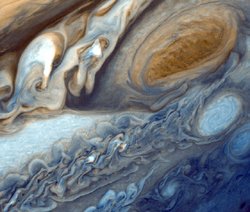Planetary And Exoplanetary Atmospheres

The Planetary and Exoplanetary Atmospheres group pursues a quantitative study of the atmospheres of major and minor bodies in the Solar System and beyond. The group's investigations of gases, aerosols, hazes, and clouds apply broadly to global climate on the planets, meteorology and weather prediction, planetary evolution, and astrobiology.
- What is the chemistry and dynamical behavior of gas giant atmospheres?
- What is the structure of the deep atmospheres of the ice giant planets?
- What has been the long-term evolution of the martian atmosphere?
- How does the presence of ice and dust aerosols in the atmosphere influence martian weather and climate?
- What is the structure of the atmosphere of Titan? How does it behave dynamically in such a unique environment?
Planetary and Exoplanetary Atmospheres: Missions and Projects
Our group’s expertise includes radiative transfer theory and remote sensing; atmospheric chemistry and composition, dynamics, structure, optics, and evolution; atmospheric process numerical modeling; atmospheric data analysis; image processing and scientific visualization. Our work covers Venus, Earth, Mars, Jupiter, Saturn, Uranus, Neptune, Pluto, outer planetary satellites, and exoplanets. We work on several missions with roles in instrument design, construction and operations, support for landing site and Entry-Landing-Descent (EDL), and ground-based support, including coordination with amateur community.